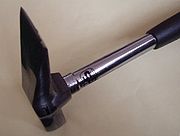
Geologist's hammer
Encyclopedia


Hammer
A hammer is a tool meant to deliver an impact to an object. The most common uses are for driving nails, fitting parts, forging metal and breaking up objects. Hammers are often designed for a specific purpose, and vary widely in their shape and structure. The usual features are a handle and a head,...
used for splitting and breaking rocks. In field geology, they are used to obtain a fresh surface of a rock in order to determine its composition, nature, mineralogy
Mineralogy
Mineralogy is the study of chemistry, crystal structure, and physical properties of minerals. Specific studies within mineralogy include the processes of mineral origin and formation, classification of minerals, their geographical distribution, as well as their utilization.-History:Early writing...
, history and field estimate of rock strength. In fossil collecting
Fossil collecting
Fossil collecting is the collection of fossils for scientific study, hobby, or profit. Fossil collecting, as practiced by amateurs, is the predecessor of modern paleontology and many still collect fossils and study fossils as amateurs...
and mineral collecting
Mineral collecting
Mineral collecting is the hobby of systematically collecting, identifying and displaying mineral specimens. Mineral collecting can also be a part of the profession of mineralogy and allied geologic specialties.-Motivations:...
, they are employed to break rocks with the aim of revealing fossils inside. Geologist's hammers are also sometimes used for scale in a photograph.
Shape
Geologist's hammers, as with most hammers, have two heads, one on either side. Most commonly the tool consists of a combination of a flat head, with either a chisel or a pick head at the other end.- A chisel head (pictured), which is shaped like a chiselChiselA chisel is a tool with a characteristically shaped cutting edge of blade on its end, for carving or cutting a hard material such as wood, stone, or metal. The handle and blade of some types of chisel are made of metal or wood with a sharp edge in it.In use, the chisel is forced into the material...
, is useful for clearing covering vegetation from exposures and is sometimes (though inadvisedly) used to pry open fissures. Some rocks can be easily split, like slate or shale, to reveal any fossils. - A pick head, which terminates in a sharp point to deliver maximum pressure, is often preferred for harder rocks. A geologist's hammer bearing a pick end is often referred to as a rock pick or geological pick instead of a geologist's hammer.
- A flat head is used to deliver a blow to a rock with the intention of splitting it. Specimens or samples can be trimmed to remove sharp corners or reduce in size.
Construction
The effective power of a geologist's hammer is mainly considered to be a reflection of its head weight and handle length. Head weight may range from 8 oz (225 g) or less on a small hammer—such as would generally be used for casual use or by children—to 24 oz (680 g) and greater. 16 oz (450 g) is often quoted as sufficient for all rock types, although metamorphicMetamorphic rock
Metamorphic rock is the transformation of an existing rock type, the protolith, in a process called metamorphism, which means "change in form". The protolith is subjected to heat and pressure causing profound physical and/or chemical change...
or igneous rocks often require heavier hammers for a more powerful blow.
The best geologist's hammers are forged from one piece of hardened steel
Hardened steel
The term hardened steel is often used for a medium or high carbon steel that has been given the heat treatments of quenching followed by tempering. The quenching results in the formation of metastable martensite, the fraction of which is reduced to the desired amount during tempering. This is the...
, which renders them sturdy and long lasting. Alternatives such as tubular and wooden shafted hammers are more commonly used, in part due to their low cost. Such alternative handles sacrifice strength and make the hammer unsuitable for high strain activities like prying.
The form and weighting of the shaft defines the balance, which itself defines the ease, efficiency and comfort of use of the geologist's hammer.

